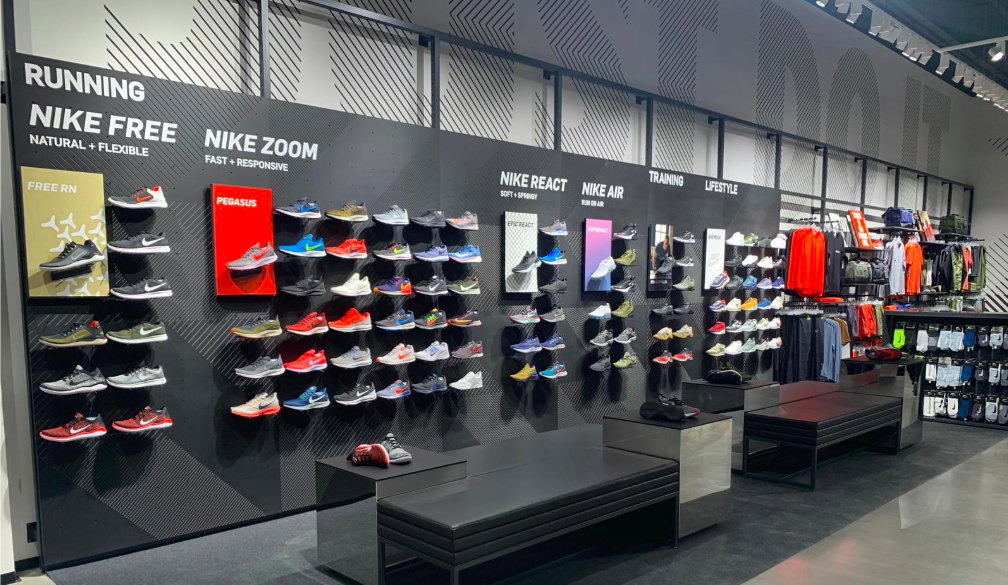Nike Inc. crushed Wall Street’s earnings targets in the second quarter. Revenues were led by currency-neutral gains of 23 percent in China and 14 percent in the EMEA region. Digital sales vaulted 38 percent and the Jordan brand logged its first-ever billion-dollar quarter. The North America region came in lower than analysts’ expected but still accelerated from the first quarter.
Margins also came in slightly below Street targets although the shortfall was attributed to currency fluctuations and tariff costs.
In the quarter ended November 30, earnings rose 31.6 percent to $1.1 billion, or 70 cents a share, topping Wall Street’s consensus estimate of 58 cents. The improvement was traced to strong revenue growth, gross margin expansion, selling and administrative expense leverage and a lower tax rate.
Revenues for Nike, Inc. increased 10.2 percent to $10.3 billion and gained 13 percent on a currency-neutral basis. Analysts had expected $10.09 billion.
Revenues for the Nike Brand were $9.8 billion, up 12 percent on a currency-neutral basis and driven by growth across wholesale and Nike Direct; key categories including Sportswear, the Jordan Brand and Running, and continued growth across footwear and apparel.
North America Fueled By Digital
By region for Nike Brand, North America’s sales improved 5.3 percent to $3.98 billion from $3.78 billion. Currency-neutral sales grew 5 percent. Currency-neutral growth accelerated from the 4 percent gain seen in the first quarter but were just short of Wall Street’s average target of $4 billion.
By category, currency-neutral sales grew 8 percent in footwear, 1 percent in apparel and 5 percent in equipment. EBIT slipped 1.0 percent to $875 million from $884 million.
The revenue gains in North America were led by digital, which grew 32 percent and was helped by growth of more than 70 percent over Black Friday weekend. The weekend broke records across many of Nike’s metrics, including its highest week of member engagement ever.
“Overall, growth was fueled by those dimensions of the marketplace that we are transforming in particular NIKE Direct and through differentiated wholesale partners like Foot Locker JD/Finish Line and Dick’s,” said Andy Campion, EVP and CFO, on a conference call with analysts. “We continue to intentionally right size undifferentiated dimensions of the marketplace. We have strong momentum in North America, which makes it the ideal time to affect this transformation.”
Campion said its key-city focus is working with New York and Los Angeles outpacing the broader market. In New York, Nike Direct is already well over 50 percent of its business and digital is already well over 30 percent penetrated.
For the second half of fiscal year 2020, comparable-store sales in North America are expected to climb in the “strong mid-single digit range” but reported revenue growth will impacted by the sale of Hurley. As reported, Nike in late October reached a definitive agreement to sell the surf brand to private equity firm Bluestar Alliance LLC. The brand’s exit will cause a roughly 2 point unfavorable comparison on North America revenue and approximately 1 point for Nike Inc.
Campion added, “That said, this is accretive from a capital deployment and profitability perspective, and our North America business on a comparable basis remains strong and we’re right on plan.”
China And EMEA Driven Outsized International Growth
Outside North America, the strongest growth came in Greater China. Sales for Nike Brand advanced 19.6 percent to $1.85 billion and added 23 percent on a currency-neutral basis, marking its 7th consecutive quarter of more than 20 percent growth. EBIT advanced 23.7 percent to $694 million.
“We saw strong double-digit growth in every key category and every dimension of the market,” said Campion.
Nike Digital once again led growth with a 44 gain on a currency-neutral basis, fueled by a record-breaking Singles Day that exceeded “ambitious” internal expectations. The gains came despite only having just launched the Nike App earlier this month. Campion said, “That is one of the many reasons we believe that while we have great current momentum in China, we are still far from realizing our full potential. While we are of course very mindful of the geopolitical dynamics in Greater China. The Nike brand continues to deeply resonate with consumers and our growth continues to be strong and sustainable.”
Campion also said the brand is proactively managing inventory in the Hong Kong market due to recent declines in retail traffic there. These actions will create a short-term headwind “on what will remain a very strong” rate of growth for China, Campion said.
Europe, Middle East & Africa (EMEA)’s sales for Nike Brand were up 9.7 percent to $2.54 billion and gained 14 percent on a currency-neutral basis. EBIT advanced 13.3 percent $510 million.
Campion said the Nike Brand is “on fire and continues to take significant market share.” The brand has become the footwear market leader in Germany, the home of rival Adidas; and continues to be the number one brand in all of its key cities within EMEA.
Double-digit growth was seen in the EMEA region in most key categories, led by Sportswear and Jordan. The growth was helped by two local campaigns. A kids-focused Just Do-It campaign celebrating girls helped drive strong double digits in kids. A second campaign celebrated the 30th anniversary of the Berlin Wall coming down with a focus on the power of sport to unite.
The Women’s business stood out, growing faster in the EMEA region than in any other geography in Q2. Nike’s Express Lane quick-turn program brought the T-100 women’s apparel pack to market in less than 120 days from initial consumer insight and the product sold out immediately through Nike Direct, Asos and Zalando. Overall, digital expanded 27 percent in the EMEA in the quarter. Campion said, “We have extraordinary momentum in EMEA and we expect to extend our lead, fueled by the Euro Champs and the Olympics over the second half of fiscal year ’20 and into fiscal year ’21.”
Asia Pacific & Latin America (APLA)’s revenues for Nike Brand were up 13.1 percent in the quarter to $1.47 billion. Currency-neutral sales gained 18 percent. EBIT climbed 17.4 percent to $377 million.
The gains were fueled by growth in Korea and Japan. Digital jumped 67 percent in Q2, continuing to lead all dimensions of growth, and aided by partnerships with digital platforms such as ZOZOTOWN and Flipkart. The first international Nike Live store opened in the quarter in Shibuya, Tokyo, next to one of the busiest train stations in the world. The Express Lane initiative created an Air Force 1 inspired by the Shibuya neighborhood and launched through the NIKE SNKR app.
The running business has “tremendous momentum” in Japan, where Nike’s market share in running reached a record high in Q2, led by the success of the Vaporfly 4% and Next%. Said Campion, “We are excited to build on this energy with the launch of new styles, like the Nike React Infinity Run next month and the strong portfolio of innovation to come around the Tokyo Olympics.”
Converse’s Rebound Boosted By China, North America Still Challenging
Converse’s sales were up 12.9 percent to $480 million and gained 15 percent currency-neutral. EBIT vaulted 104.5 percent to $90 million from $44 million.
The gains were driven by double-digit growth in Asia and Europe, as well as through digital globally. Converse growth accelerated from the 8 percent currency-neutral gain seen in the first quarter and is regaining momentum. Sales were up only 3 percent on a currency-neutral basis in fiscal 2019 and were down 11 percent in fiscal 2018.
Mark Parker, chairman, president and CEO, said on the call that Converse’s gain was particularly led by China but the brand is also seeing a “strong performance” in the EMEA region, driven by digital.
“So we’re seeing incredible momentum for Converse really starting to build in those markets,” said Parker. “We have some gaps to close in North America. We are continuing to differentiate our product line beyond the Chuck. And I think that will create some more opportunities for us in basketball. We’re looking at running and some other dimensions of the Converse footwear portfolio, apparel as well.”
One successful differentiation is the Chuck 7, a premium version of the classic Chuck Taylor, that is seeing growth in the double to triple digits in all geographies.
In North America, Converse is seeing strong growth digitally. Parker added, “So we think that’s a sign of some optimism for us for Converse in North America going forward. And I think the expansion of our digital platform for Converse is going to be a driver globally, certainly led currently by China, but we’ll start to see that happen more and more in North America and for Europe.”
Gross margin companywide increased 20 basis points to 44.0 percent, primarily due to higher average selling prices and margin expansion in Nike Direct and Converse, partially offset by impacts from higher product costs, primarily due to incremental tariffs in North America.
Selling and administrative expense increased 6 percent to $3.3 billion. Demand creation expense was $881 million, down 3 percent due primarily to a timing shift of investment in certain brand campaigns. Operating overhead expense increased 9 percent to $2.4 billion driven by continued investments in transformational capabilities, particularly in Nike Direct and global operations.
Inventories for Nike Inc. were $6.2 billion, up 15 percent compared to the prior-year period, reflecting strong consumer demand globally as well as a higher rate of on-time factory deliveries, and to a lesser extent, the impact from changes in foreign currency exchange rates.
Low-Double Currency-Neutral Growth Now Expected For Fiscal 2020
Nike said it now expects to currency-neutral revenue growth in the low double-digit range, including the impact from the sale of Hurley. That’s up from prior guidance calling for currency-neutral growth in the high-single digits range.
The company continues to expect high single-digit reported revenue growth for the full year. Also in line with past guidance, gross margins are expected to expand within the 50 basis point to 70 basis point range and SG&A to grow in the high single-digit range.
For the third quarter, currency-neutral revenue growth is expected to climb on the lower end of the high single-digit range, Q3 reported revenue will be in line with the 7 percent growth seen in Q1 and includes roughly 2 points of foreign exchange headwinds and the non-comp impact related to the sale of Hurley.
Gross margins in the third quarter are expected to be flat compared to the prior year. Strong underlying product margin expansion, reflecting the strength of its product pipeline, is expected to largely offset by tariffs in North America and supply chain investments. SG&A growth is expected in the low double-digit to low teens range, driven by Nike’s decision within Q2 to shift marketing demand into the second half in order to amplify the NBA All-Star Weekend European Championships, the Tokyo Olympics and support for key product launches.
Photo courtesy Nike
















